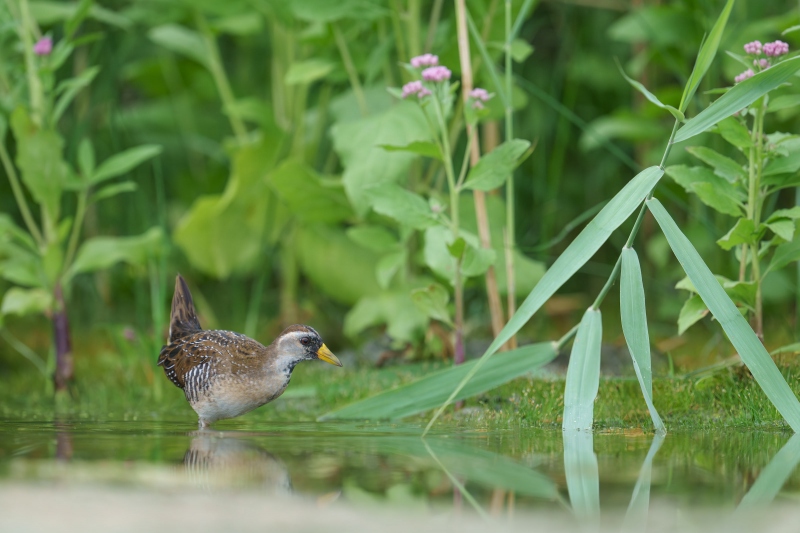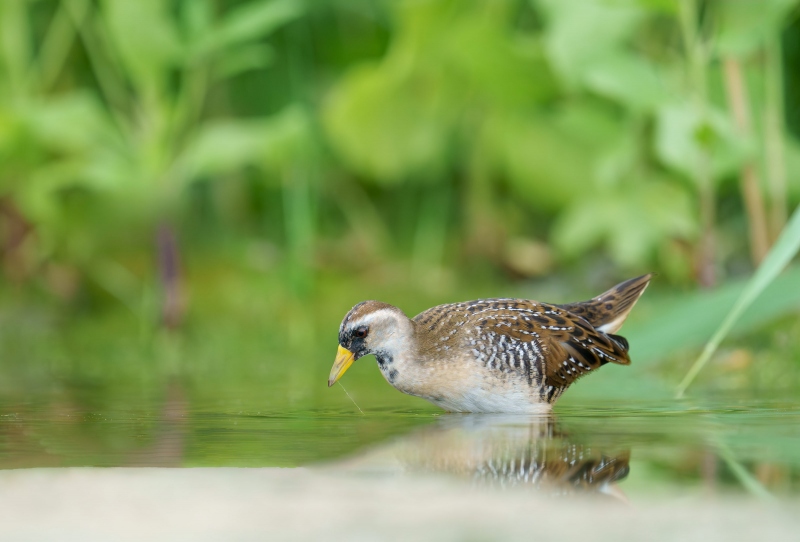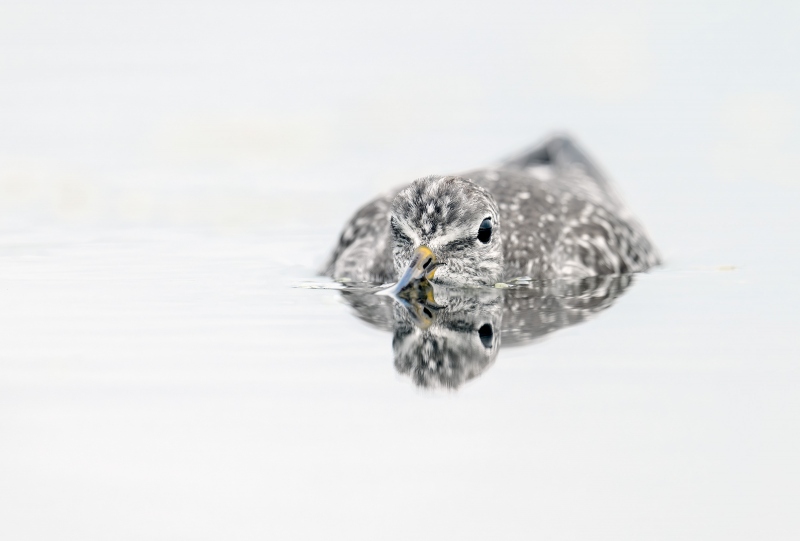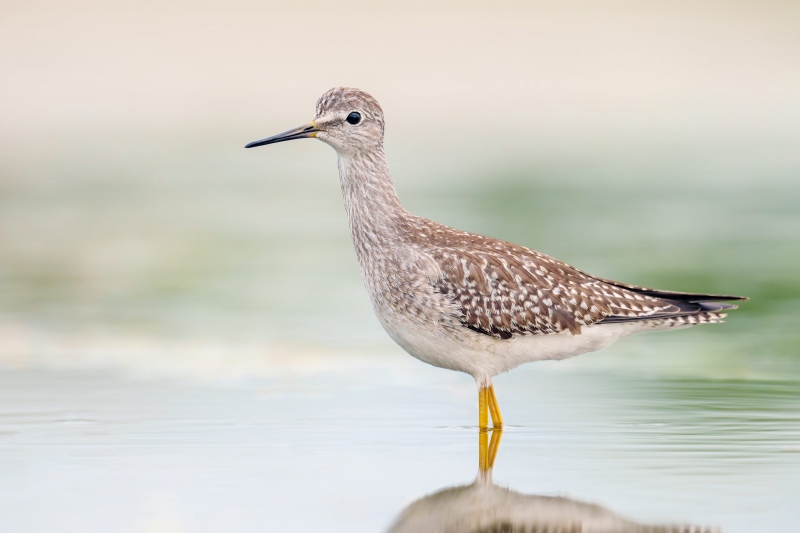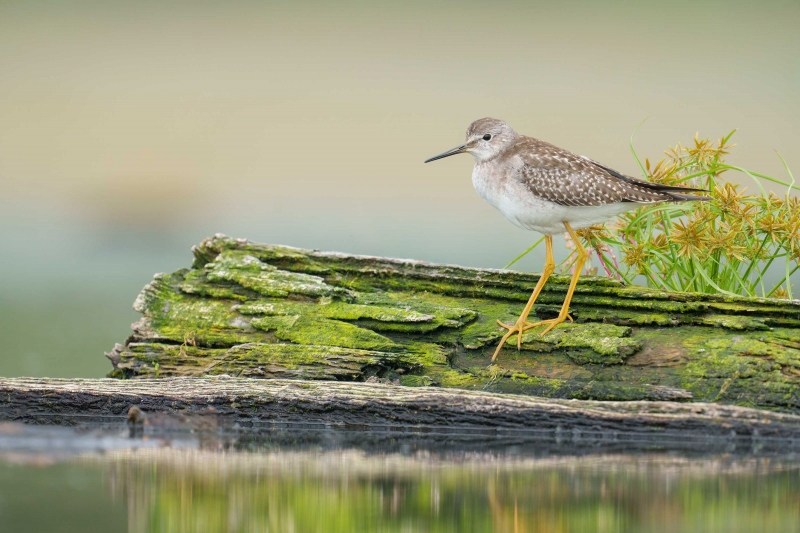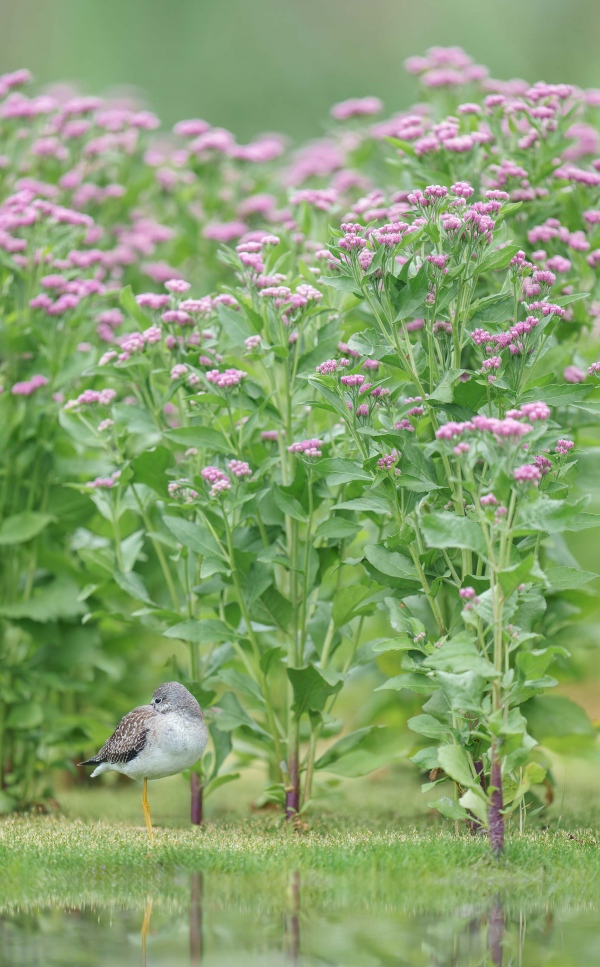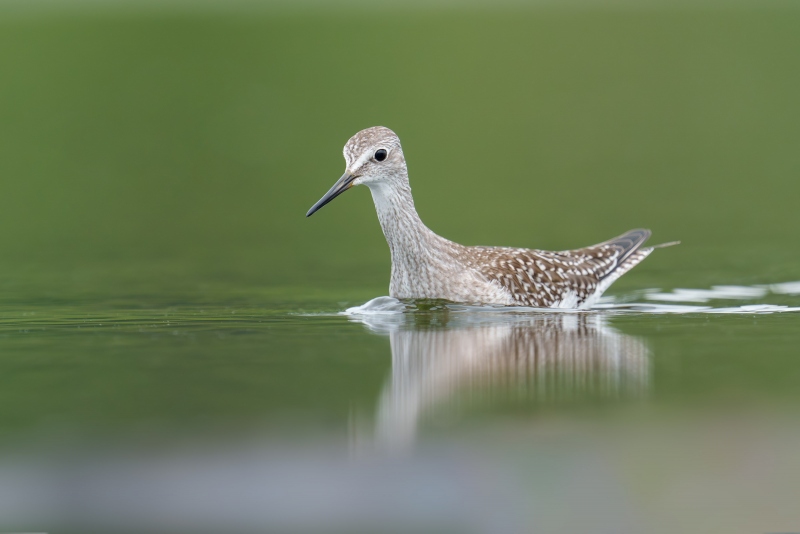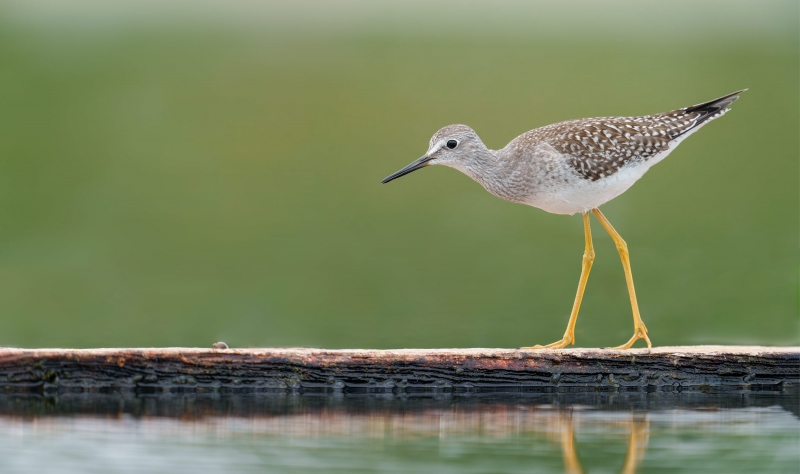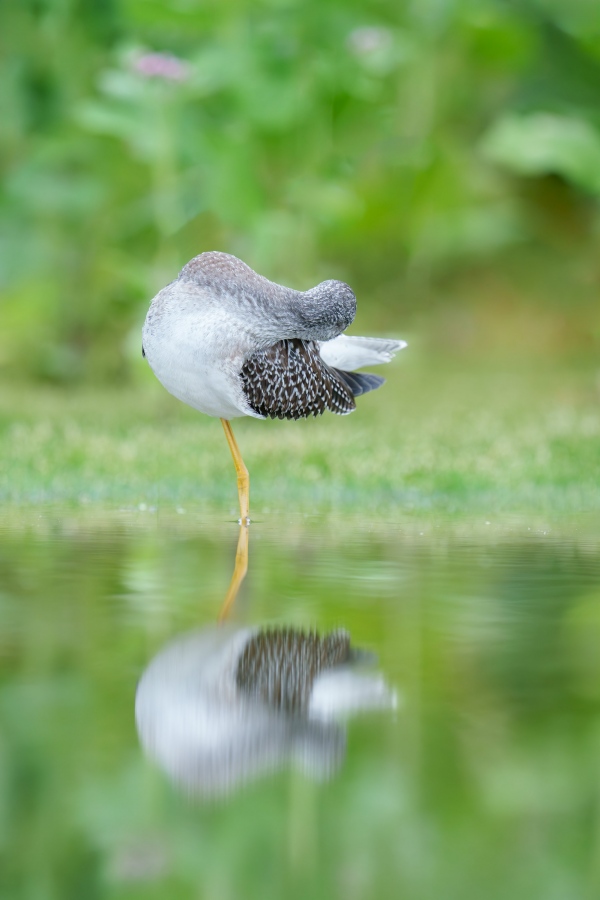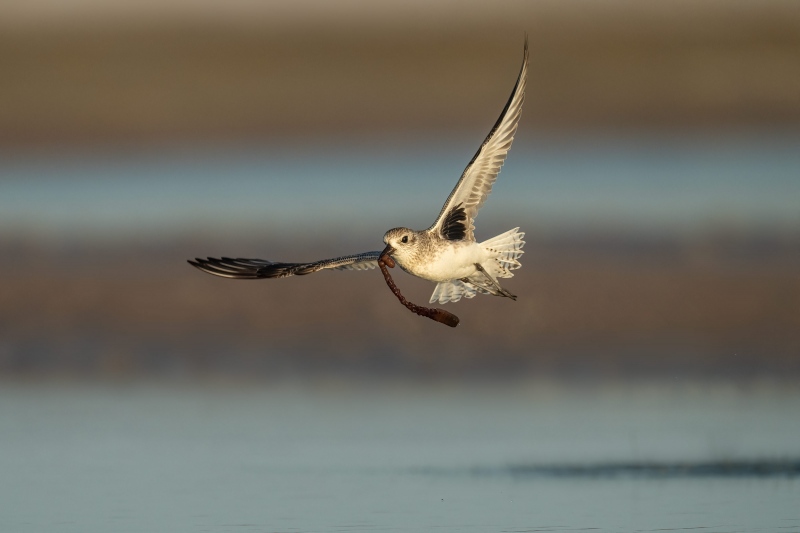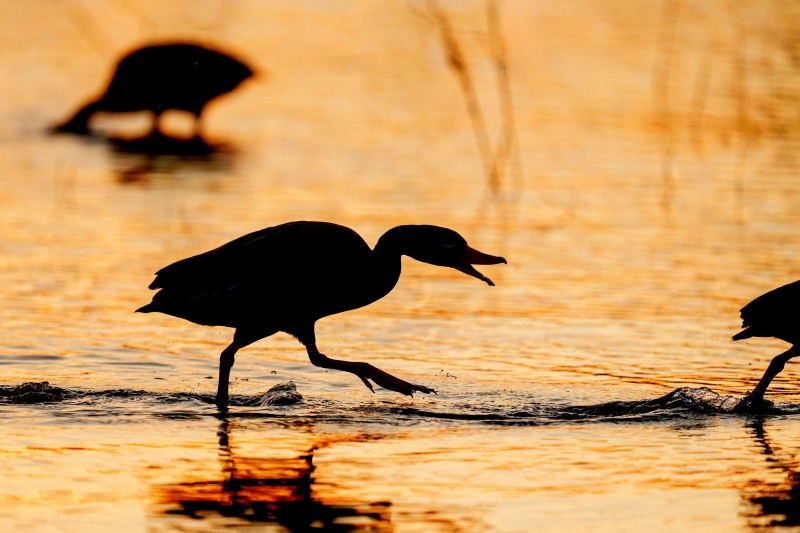September 4th, 2024 Your Call
Thanks for the plethora of thoughtful comments at the last blog post. Which of today’s two featured Sora images do you like best? Please be so kind as to share your thoughts as to why you made your choice.
In Image #1, the yellowlegs was lying down flat in the water to hide from a falcon that flew overhead. I actually preferred the near B&W version to the more natural color in Image #2.
Nobody came close to answering the High Level Focusing Technique Question that accompanied Image #4. Give it a try. There are clues in the text and another one in the comments, but you will need to put your thinking cap on.
As for favorites, all but Image #2 got at least vote. One reader would have deleted Image #7. Another picked it as his favorite. Two folks loved Image #4; it was my least favorite of the seven. My top pick was #6 for its simplicity and the gorgeous background.
What’s Up?
I saw Dr. Puopolo on Tuesday afternoon to have the seven stitches removed from the base of my right thumb. The news was about what I expected, but a bit better than that. Both incisions healed perfectly. He told me that the tenderness I’ve been feeling on the inside of my right ring finger is because when the surgery is done, they stay to the left side of the nerve “for a variety of anatomical reasons” and that it typically disappears over time as the nerve calms down. I am thrilled with the results of the two operations, especially because the crushing episodes of tingling, numbness, and pain are completely gone. He is such a cool guy. I was going to confess my sins of going out to photograph twice to JBWR. When I began by saying, “I’ve been a bad patient.” He said, “Don’t tell me.” I thanked him again and we exchanged hugs.
Today is Wednesday 4 September. I set the alarm for oh-dark-hundred (3:34am) but woke at 3:00am so I got up and hit the road before 4:00am for my drive down to Lorton, VA to catch the Auto Train south late this afternoon. If all goes as expected, I should be home at about 1pm on Thursday. Whatever you are doing, I hope that you too choose to have fun and enjoy life.
Used Gear New Listngs
Sony FE 200-600mm f/5.6-6.3 G OSS Lens
BAA-friend Greg Clarkson is offering a Sony FE 200-600mm f/5.6-6.3 G OSS Lens in Like-new condition for a ridiculously low $1299.00. This lens has never been in the field. The sale includes the front and rear lens caps, the lens hood, the lens strap, the original product box, the lens case, and insured ground shipping via major courier to lower-48 US addresses only. Your item will not ship until your check clears unless other arrangements are made.
Please contact Greg via at e-mail.
The Sony 2-6 is an amazingly versatile relatively inexpensive telephoto zoom lens. It sells new for $1898.00. If you would like to get started with Sony and bird photography and cannot afford the 300mm f/2.8 GM lens then grabbing George’s pretty much new lens would be a very smart move. artie
Sony FE 90mm f/2.8 Macro G OSS Lens
Sold the first day of listing!
BAA-friend Greg Clarkson is offering a Sony FE 90mm f/2.8 Macro G OSS Lens in Like-new condition for a ridiculously low $698.00. This lens has never been in the field. The sale includes the front and rear lens caps, the lens hood, the original product box, the lens pouch, and insured ground shipping via major courier to lower-48 US addresses only.
Your item will not ship until your check clears unless other arrangements are made.
Please contact Greg via at e-mail.
Sony’s longest macro lens sells new for $998.00. If you love macro photography, grabbing Greg’s pretty much new lens right now would be the best option. artie
Get up close and personal with the 1:1 magnification ratio of the full-frame compatible Sony FE 90mm f/2.8 Macro G OSS Lens. As a G series lens, it perfectly balances sharpness and bokeh and, as a macro lens, close and controlled focusing performance is prioritized with advanced AF and intuitive handling. B& & Sony
My First Sora?
I may have seen and/or photographed this species somewhere before, but neither the experience nor the images (???) were in any way memorable. Thus, I do not remember when, where, or even if 🙂 Thanks again to the very nice Asian lady who pointed the bird out to me as it skulked around the edge of one of the two small ponds that abutted the phragmites at the south end of the East Pond at JBWR on Saturday last.
Strategy for Photographing a Rare or Uncommon Bird
When you come across a group of birders viewing a rare or uncommon species with binoculars and/or spotting scopes, you should first consider some common sense field etiquette before trying to create some images. The same is true even if they are looking at a group of commonly seen species. Walking slowly up to the group and asking where the group is from and what they are seeing is often a good start.
Unless they are very close to what they are looking at, you should put photography out of your mind at least for a few minutes. When they move along, you may begin your approach.
As I had heard that the Sora had been around the pond for at least two days and they were looking to the southeast, I knew exactly what they were looking at. Anyhoo, I walked up to the group and said “Hi” to Emme, a friendly young woman with binoculars and a field notebook, “what’s the group?” I figured it might be a local Audubon Group. “We’re the Queer Birders,” she replied.
We chatted for a while as I shared a bit of the history of the East Pond and a bit of the history of Arthur Morris/BIRDS AS ART. (Note: the two are intricately interwoven.) You can check them out here on Instagram. They have an absolute ton of great bird walks and trips in and around NYC.
After a few minutes, the group drifted off to the north. One photographer who had stayed a good distance away from the pond remained. After I finally spotted the bird (albeit with help, as above), I judged its behavior as “could-care-less.” So I flattened my tripod, crouched down a bit, walked slowly past the single photographer to the edge of the pond, got down on the ground, and worked the bird for about ten minutes until it disappeared into the reeds.
You might think that my courteous behavior was rewarded, or that I had gotten lucky.
Note that approaching a bird or a flock of birds that is being viewed by others who were there before you is 100% rude and improper. (It would be nice if the birders acted in a similar manner; often, they do not.)
Typos
With all blog posts, feel free to e-mail or to leave a comment regarding any typos or errors.
September 2nd, 2024 Working a Subject
Photographing a species and then checking it off your list is not something that I strive to do. The idea is to create interesting images. Though each of today’s photos is of the same subject, juvenile Lesser Yellowlegs, each is distinctly different. There are a variety of behaviors, poses, habitats, and image formats and designs.
Your Call?
Which of today’s seven featured images is the strongest? Please be so kind as to leave a comment and let us know why you made your choice.
Please note that there are several additional questions below; each is designed to make you think and hopefully, to help you become a better bird photographer.
What’s Up?
With high tide at 7:20am and cloudy skies and a southeast wind forecast for Friday past, I set my alarm for 5:15am and arrived at Jamaica Bay Wildlife Refuge just after 6:15am. I had planned on visiting the East Pond on the Combo IPT on the previous set of morning high tides but things were so good at Nickerson Beach that Geri and I never made it.
As I walked out onto the pond, I was delighted to note the low water level. Kudos to the refuge management for getting the gate valve at the north end of the pond repaired and keeping the water down despite lots of recent rain. What struck me the most, were the huge stands of blossoming saltmarsh fleabane (Pluchea odorata) that covered acres and acres of shoreline. On 46 years of previous visits, you might see a few plants blossoming at the end of August.
I was feeling quite nostalgic as I traversed the pond. Forty-eight years ago, on my first visit to the East Pond, I saw a Marbled Godwit that wound up changing the remainder of my adult life. I thought of the late Thomas H. Davis Jr, all 145 pounds, 6′ 9″ of him. He taught me to identify and age the shorebirds that visit the pond every season. I thought of my late wife Elaine picking up a dying Forster’s Tern and comforting it. Memories of rare birds and two Jewish high holiday screw-ups flooded my mind and left me feeling quite emotional at times.
I was glad to see lots of shorebirds on the pond. I began on the South Flats and made my way up to the Raunt stopping several times to photograph. I left quite satisfied at about 11:00am. I hit the sack early on Saturday night and woke completely refreshed at 4:45am. I had not planned on returning to the pond but figured what the heck. After making some raspberry tea, I headed back to the East pond leaving at 5:45am.
With the wind having switched to the southwest, I was not feeling stoked. The morning began slowly but then things got better and better. I had lots of birds posing on the weathered boards at the Raunt and right before I headed home at 11:30am, I got my best ever, heck, probably my first ever, images of a Sora, a small usually secretive rail.
Today is Monday September 2, 2024. With a cold northwest wind in the forecast, I opted to stay home and begin packing up for my trip home. I see Dr. Pop tomorrow to have the seven stitches removed from the back of my right thumb. Whatever you opt to do, I hope that you choose to have fun.
Please remember to use the B&H links that are found on most blog pages and to use the BIRDSASART discount code at checkout when purchasing your new gear from Bedfords to get 3% back on your credit card and enjoy free second-day air FedEx. Please, also, consider joining a BAA IPT. You will be amazed at how much you will learn!
If an item — a Delkin flash card, or a tripod head — for example, that is available from B&H and/or Bedfords, is also available in the BAA Online Store, it would be great, and greatly appreciated, if you would opt to purchase from us. We will match any price. Please remember also to use my B&H affiliate links or to earn 3% cash back at Bedfords by using the BIRDSASART discount code at checkout for your major gear purchases. Doing either often earns you free guides and/or discounts. And always earns my great appreciation.
Supporting My Efforts Here
If you enjoy and learn from the blog, please consider using one of my affiliate links when purchasing new gear. It will never cost you a single penny. To support my effort here, please order from B&H by beginning your search here. Or, click here, to order from Bedfords and enter the discount code BIRDSASART at checkout to receive 3% cash back to your credit card and enjoy free Second-Day Air Fed-Ex shipping. It is always best to write for advice via e-mail.
In many cases, I can help you save some serious dollars. And/or prevent you from purchasing the wrong gear.
Behavior Question
Why is this bird lying flat in the water?
|
|
|
This image was created on 31 August 2024 at the East Pond, Jamaica Bay Wildlife Refuge, Queens, NY. Seated on damp grass I used the heel-pod technique to get as low as possible with the Sony FE 600mm f/4 GM OSS lens and The One, the Sony Alpha 1 Mirrorless Digital Camera.. ISO 2000. The exposure was determined by Zebras with ISO on the rear wheel: 1/640 second at f/5.6 (stopped down one full stop for depth of field) in Manual mode. RawDigger showed the raw file brightness to be dead solid perfect. AWB at 8:15:27am on a very cloudy morning.
Tracking: Zone/AF-C with Bird-Eye/Face Detection performed perfectly. Click on the image to enjoy the high-res version.
Image #2: Lesser Yellowlegs — worn juvenal plumage standing
|
Image Optimization Question
Images #1 and #2 are of the same bird photographed in the same light just minutes apart. For the first image, I desaturated it completely but for the yellow on the bill that was then juiced up. The color in the second image is much more accurate. Which version do you prefer?
Because of the answer to the behavior question above, this bird posed quite close to me long enough for me to remove the 1.4X TC, take the right off the tripod, and make several images. I will share my choice in the next blog post.
The Raunt
About 1/4 of the way up the eastern shore of the East Pond (heading north, toward the city), you will come across the remains of a circa 1950s baymen’s community.
Many lengths of weathered timber can be found in the area. Most are covered with algae and some have a variety of wetlands vegetation growing on them. These old rotting beams and planks make ideal perches for the visiting shorebirds because you get to see their feet (usually unseen in an inch or two of brackish water).
|
|
|
This image was created on 31 August 2024 at the East Pond, Jamaica Bay Wildlife Refuge, Queens, NY. Seated on damp grass and mud behind my flattened Robus RC-5570 Vantage Series 3 Carbon Fiber Tripod/Levered-Clamp FlexShooter Pro-mounted Sony FE 600mm f/4 GM OSS lens and The One, the Sony Alpha 1 Mirrorless Digital Camera.. ISO 800. The exposure was determined by Zebras with ISO on the rear wheel: 1/500 second at f/4 (wide open) in Manual mode. RawDigger showed the raw file brightness to be perfect. AWB at 10:03:17am on a very cloudy morning.
Focus was acquired via Tracking: Expand Spot AF/C. Then I turned the AF switch to M (Manual Focus) and made sure not to touch the focusing ring. Click on the image to enjoy the high-res version.
Image #4: Lesser Yellowlegs — worn juvenal plumage resting in front of a stand of saltmarsh fleabane
|
High Level Focusing Technique Question
Why did I focus first and then move the autofocus switch to OFF? Clue: I would not have had to do this if I had been using the a9 iii rather than the a-1.
Swimming Shorebirds
Only a few species of shorebirds swim. Among those are all of the Tringas (including both our yellowlegs), Stilt Sandpiper, all of the avocets including our American Avocet, and somewhat surprisingly, Red Knot and Dunlin.
Sometimes Praying Helps
The yellowlegs in Image #6 was fishing well within range of my 840mm rig. I talked softly to it, “Up on the log, please.” I prayed a bit. Then my prayers were answered.
Sora Distraction
For two days, folk had been telling me about a Sora in a small pond on the South Flats. I had looked for it several times without success. I checked the location one last time before heading home on Sunday but did not see the bird. Thanks to the Asian woman who pointed it out to me. Typically, the Sora was playing hide and seek in the reeds that fringed the pond. When it hid, I photographed the preening Lesser Yellowlegs.
Note that this individual is in the freshest juvenal plumage of the lot with the upperparts’ feathers looking more black and white than brownish and white.
Image Question
Would you delete this image because the bird’s face is hidden? Why or why not?
Typos
With all blog posts, feel free to e-mail or to leave a comment regarding any typos or errors.
August 30th, 2024 What’s Up?
My right hand continues to heal nicely. The thumb (trigger finger) was as good as new the next day. The stitches come out next Tuesday. Though the crushing, tingling pain in the hand is gone, it appears that I will have some lingering tenderness along the inside of the ring finger of my right hand for quite some time as the nerve heals and calms down.
I have been getting lots of rest at younger daughter Alissa’s home in Ronkonkoma, Long Island, and have been taking a 1 1/2 mile sun walk every afternoon. Older daughter Jennifer and her husband Eric flew to Long Island MacArthur Airport in nearby Islip on Thursday afternoon and we all enjoyed a fabulous spaghetti squash lasagna prepared by Alissa followed by an absolutely sinful dessert, Best S’mores Bars: chocolate, peanut butter, and marshmallow sandwiched between two layers of a graham cookie crust.
Today is Friday 30 August 2024. I will continue working on a new writing project and a Getty Pacific-race Brown Pelican image submission. Whatever you opt to do, I hope that you too choose to have fun and to enjoy life.
Please remember to use the B&H links that are found on most blog pages and to use the BIRDSASART discount code at checkout when purchasing your new gear from Bedfords to get 3% back on your credit card and enjoy free second-day air FedEx. Please, also, consider joining a BAA IPT. You will be amazed at how much you will learn!
If an item — a Delkin flash card, or a tripod head — for example, that is available from B&H and/or Bedfords, is also available in the BAA Online Store, it would be great, and greatly appreciated, if you would opt to purchase from us. We will match any price. Please remember also to use my B&H affiliate links or to earn 3% cash back at Bedfords by using the BIRDSASART discount code at checkout for your major gear purchases. Doing either often earns you free guides and/or discounts. And always earns my great appreciation.
Supporting My Efforts Here
If you enjoy and learn from the blog, please consider using one of my affiliate links when purchasing new gear. It will never cost you a single penny. To support my effort here, please order from B&H by beginning your search here. Or, click here, to order from Bedfords and enter the discount code BIRDSASART at checkout to receive 3% cash back to your credit card and enjoy free Second-Day Air Fed-Ex shipping. It is always best to write for advice via e-mail.
In many cases, I can help you save some serious dollars. And/or prevent you from purchasing the wrong gear.
Save 15%!
If you’d like to try out a new lens or if you need a lens for a specific trip or project (or for an IPT), LensRentals.com is the only way to go. To save 15%, simply click on the logo link above, arrange for your rental, and type in BIRDSASART15. If you type the gear you are looking for in the search box, it will pop right up. LensRentals.com offers affordable insurance. You can decline it, opt for LensCap: Damage Only, or select LensCap: Damage & Theft. Then hit PROCEED TO CHECKOUT. After you enter all of your info but before completing your order, be sure to scroll down to Promo Code box and enter the BIRDSASART15 code to save 15%.
I checked on renting a Sony FE 70-200mm f/2.8 GM OSS II lens for a week. The cost is only $122.00. LensCap: Damage Only coverage can be added for a very low $18.00. Going with LensCap: Damage & Theft would be $27.00. The shipping charge varies. They offer an interesting program called Lensrentals HD. By signing up for this shipping discount program ($99.00/year), you’ll get free Standard Shipping on all the orders you place.
Renting a Sony 600mm f/4 GM OSS lens for a week will cost you $536.00. The two coverage options come in at $76.00 or $114.00. Less your 15% discount when you enter the BIRDSASART15 code into the Promo Code box at checkout and enter the BIRDSASART15 code in the Promo Code box at checkout to save 15%.
Remember, to save the 15% on your rental you must start your search by clicking on the logo above, or on this link: LensRentals.com


B&H
To ensure that I get credit for your B&H purchases, you can always click here. The tracking is invisible but greatly appreciated. And, you can use your PayBoo card. You must use the website to order. B&H will reopen on Fri April 14. Thanking me for the past 4000 educational blog posts could not be any easier and will not cost you one penny. Please shoot me your B&H receipt for major purchases.
Many folks have written recently stating that they purchased a Sony a1 from B&H and would like their free membership in the Sony 1 Info and Updates Group, a $150.00 value. When I check my affiliate account, their orders have not been there. When I let them know that they get credit for B&H purchases only if they use one of the many B&H affiliate links on the blog or begin their searches with this link, they are always disappointed. If in doubt, please contact me via e-mail and request a BH link. I am always glad to help and to guide you to the right gear.
Bedfords Simplified
Click here to start your search. Choose standard shipping, and when you get to the payment page, enter BIRDSASART in the discount code box and hit apply. You will be upgraded to free second day air Fed-Ex and receive 3% cash back on your credit card once your stuff ships. Either is greatly appreciated by yours truly.
Bedfords Amazing BAA Discount Policy
Folks who have fallen in love with Bedfords can now use the BIRDSASART coupon code at checkout to enjoy a post-purchase, 3% off-statement credit (excluding taxes and shipping charges) on orders paid with a credit card. The 3% credit will be refunded to the card you used for your purchase. Be sure, also, to check the box for free shipping to enjoy free Second Day Air Fed-Ex. This offer does not apply to purchases of Classes, Gift Cards, prior purchases.
Visit the Bedfords website here, shoot Steve Elkins an e-mail, or text him on his cell phone at (479) 381-2592.
Gear Questions and Advice
Too many folks attending BAA IPTs and dozens of photographers whom I see in the field and on BPN, are — out of ignorance — using the wrong gear, especially when it comes to tripods and more especially, tripod heads. And the same is true in spades when ordering new camera bodies or lenses. My advice will often stave you some serious money and may help you avoid making a seriously bad choice. Please know that I am always glad to answer your gear questions via e-mail. If you are desperate, you can try me on my cell at 863-221-2372. Please leave a message and shoot me a text if I do not pick up.
Lugworm City!
The lugworm (Arenicola marina) is a large marine worm of the phylum Annelida. Its coiled castings are a familiar sight on a beach at low tide, but the animal itself is rarely seen except by those who, from curiosity or to use as fishing bait, dig the worm out of the sand. At DeSoto, it is a favorite food of the Marbled Godwits that will often work for minutes extracting the worms from their holes. Black-bellied Plovers and Willets will almost always attempt to steal a just-captured lugworm from the larger godwits.
The plover in Image #1 grabbed the lugworm from a Marbled Godwit and flew right at me. Note that the black axillary (armpit) feathers are diagnostic of Black-bellied Plover and separate them from the slimmer, shorter-billed, (much rarer along the east coast) American Golden-Plover.
Photo Tip
Whenever the possibility of action exists, it is usually best to select a fast shutter speed along with the relatively high ISO that will result in a properly exposed to the right raw file. At times a shutter speed of 1/2000 sec. (or even slower) will suffice. Shutter speeds of 1/4000 sec. are ideal for flight and for action.
|
|
|
This image was created at Indian Lake Estates, FL from the driver’s seat of my SUV on 30 May 2024. I used the BLUBB-supported Sony FE 600mm f/4 GM OSS lens and The One, the Sony Alpha 1 Mirrorless digital camera.. Exposure was determined via Zebras with Exposure Compensation on the rear dial. Multi-Metering +2.0 stops. AUTO ISO set ISO 2500. 1/4000 sec. at f/4 (wide open) in Shutter Priority mode. AWB at 8:03:26pm just before sunset.
Zone/AF-C was active at the moment of exposure and performed perfectly. Be sure to click on the image to enjoy the larger version.
Image #2: Black-bellied Whistling Duck chasing another
|
Real Photographers Use Manual Mode 100% of the Time. Not!
There are many who firmly state that real photographers use Manual mode 100% of the time. For years, I have firmly disagreed.
In bird photography, the main reason we work in Manual mode more than 90% of the time is that the tonality of the background changes frequently and often. In Manual mode, we determine and set the correct exposure for the bird manually so that the changing background tonalities will not screw things up as they would if we were working in an automatic (exposure) mode.
There are times, however, when working in situations where the tonality of the background is relatively consistent that working in Shutter Priority mode offers some huge advantages. At the beach, before the sun comes up, the sky, the water, and the beach are all of about the same tonality, each much lighter than a middle tone. As the possibility of creating some nice pleasing blurs exists, I will set up the camera as follows: AUTO ISO, Exposure Compensation (EC) on the thumb dial, and Shutter Priority. Then I’ll usually set the EC to +2 1/3 stops and the shutter speed to 1/15 sec., the classic blur speed.
The camera sets the ISO and the well-to-the-right exposures are excellent. And, I can quickly and easily change the shutter speed during a blastoff to try for a different effect. If a nice bird lands right in front of me, I can quickly dial the shutter speed up to 1/60 or 1/125 sec. and begin making sharp images almost instantly (without having to change both the shutter speed and the ISO as I would have had to do had I been working in Manual mode). Note: By using Zebra technology, I can always tweak the EC as needed.
I often use a similar strategy when photographing action against brightly colored skies or their reflection off the water (as in Image #2, above). I will set a fast shutter speed and an EC of +2 or so. As noted above, the camera will set the ISO. This approach works perfectly if either the sun is well muted or not in the frame. If I want to try for an image with the bird crossing in front of a partially muted sun, I can reduce the EC depending on the exact situation.
This approach will be far more efficient than opting to work in Manual mode “100% of the time.”
Note: some camera bodies allow you to save a combination of settings as a Custom Setting and usually denote them as C1, C2, or C3. That done you can do everything noted above in one fell swoop simply by moving the main dial from M to 1 (for example).
Your Call?
Which of today’s two featured images is the strongest? Please be so kind as to leave a comment and let us know why you made your choice.
Typos
With all blog posts, feel free to e-mail or to leave a comment regarding any typos or errors.
|
|

